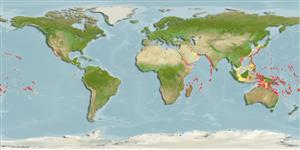Echinoidea |
Diadematoida |
Diadematidae
Environment: milieu / climate zone / Mức độ sâu / distribution range
Sinh thái học
Cùng sống ở rạn san hô; Mức độ sâu 1 - 220 m (Tài liệu tham khảo 95661). Tropical
Indo-Pacific: from Indian Ocean to Tahiti and from Japan to South Pacific Islands.
Length at first maturity / Bộ gần gũi / Weight / Age
Chín muồi sinh dục: Lm ? range ? - ? cm Max length : 20.0 cm WD con đực/không giới tính; (Tài liệu tham khảo 87895)
Occurs in shallow coral and coral rubble areas at depths of 1 to 40 m (Ref. 81254), coral reefs and sandy areas (Ref. 129602). A generalist herbivore displaying nocturnal feeding behavior (Ref. 81254). Known to graze (Also Ref. 129602) on organic material and adults may also feed on live hard corals. Sometimes associated with commensal shrimp Stegopontonia commensalis (Ref. 800). Commonly found with Diadema spp. Bioeroder. Feeds on small and turf algae over hard substrates (Ref. 129602).
Life cycle and mating behavior
Chín muồi sinh dục | Sự tái sinh sản | Đẻ trứng | Eggs | Sự sinh sản | Larvae
Members of the class Echinoidea are gonochoric. Fertilization is external. Brooding is common, eggs are held either on the peristome, around the periproct or deep into the concavities on the petaloids. Life cycle: Embryos develop into planktotrophic larvae (echinoplateus) and live for several months before they sink to the bottom using their tube feet to adhere on the ground where they metamorphose into young urchins.
Schoppe, S. 2000 A guide to common shallow water sea stars, brittle stars, sea urchins, sea cucumbers and feather stars (echinoderms) of the Philippines. Times Media Private Limited, Singapore. 144 p. (Tài liệu tham khảo 800)
IUCN Red List Status
(Tài liệu tham khảo 130435: Version 2025-1)
CITES status (Tài liệu tham khảo 108899)
Not Evaluated
CMS (Tài liệu tham khảo 116361)
Not Evaluated
Threat to humans
Venomous (Tài liệu tham khảo 129602)
Human uses
Các nghề cá: Tính thương mại
| FishSource | Biển chung quanh ta
Các công cụ
Thêm thông tin
Population dynamicsSự sinh trưởngMax. ages / sizesLength-weight rel.Length-length rel.Length-frequenciesMass conversionSự phong phú Life cycleSự tái sinh sảnChín muồi sinh dụcSự sinh sảnĐẻ trứngEggsEgg developmentLarvae PhysiologyThành phần ô-xy
Human RelatedStamps, coins, misc.
Các nguồn internet
Estimates based on models
Preferred temperature
(Ref.
115969): 24.7 - 28.9, mean 27.5 (based on 362 cells).
Fishing Vulnerability
Low vulnerability (10 of 100).
Price category
Unknown.
Nutrients : Calcium = 126 [75, 177] mg/100g; Iron = 5.08 [1.67, 7.92] mg/100g; Protein = 12%; Omega3 = 0.331 [0.263, 0.400] g/100g; Selenium = 0.04 [48.48, 67.17] μg/100g; VitaminA = 0 μg/100g; Zinc = 1.97 [0.92, 3.02] mg/100g (wet weight); based on
nutrient studies.
